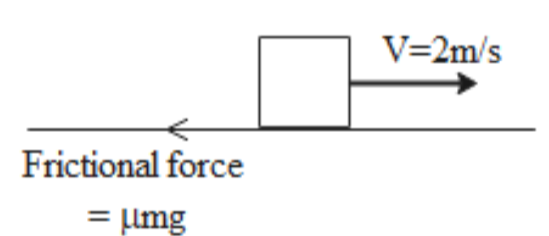Answer
399.3k+ views
Hint: The work done by an applied force is equal to the product of the force applied and the displacement produced in the body. The force here is due to the friction between body and the horizontal plane and for displacement we have value of velocity and time taken.
Formula used: $F = \mu mg$ , $d = {\text{v}} \times {\text{t}}$, $W = F \times d$
Complete step- by- step solution:
Frictional force is a force which comes into action when two bodies slide over one another. This force is large when the surfaces are rough and small for smooth surfaces. The amount of friction that a surface exhibits can be characterized by what we call a coefficient of friction.
Coefficient of friction is defined as the ratio of the frictional force between two surfaces and the force that is keeping in contact with each other. The expression for frictional force is
$F = \mu mg$ where $\mu $ is the coefficient of friction and it is dimensionless and does not have any units.

When a force is applied on a body, it gets displaced if the applied force is greater than the frictional force between two bodies. The displacement of a body is given in terms of its velocity and time interval as
$d = {\text{v}} \times {\text{t}}$
We are given:
m = 2 kg
v = $2m{s^{ - 1}}$
$\mu = 0.2$
t = 5 s
$g = 9.8m/{s^2}$
Work done = Force x displacement
$W = F \times d$
Substituting various values, we get
$
W = \mu mg \times {\text{v}} \times {\text{t}} \\
\Rightarrow W = 0.2 \times 2 \times 9.8 \times 2 \times 5 \\
\Rightarrow W = 39.2J \\
$
Therefore, the correct answer is option A.
Note:
1. The units must be in the same system.
2. In practical applications, friction is always there between two bodies and $F = \mu mg$ is used as a general expression. F = mg is considered a special case when there is no friction between bodies and coefficient of friction is equal to 1.
Formula used: $F = \mu mg$ , $d = {\text{v}} \times {\text{t}}$, $W = F \times d$
Complete step- by- step solution:
Frictional force is a force which comes into action when two bodies slide over one another. This force is large when the surfaces are rough and small for smooth surfaces. The amount of friction that a surface exhibits can be characterized by what we call a coefficient of friction.
Coefficient of friction is defined as the ratio of the frictional force between two surfaces and the force that is keeping in contact with each other. The expression for frictional force is
$F = \mu mg$ where $\mu $ is the coefficient of friction and it is dimensionless and does not have any units.

When a force is applied on a body, it gets displaced if the applied force is greater than the frictional force between two bodies. The displacement of a body is given in terms of its velocity and time interval as
$d = {\text{v}} \times {\text{t}}$
We are given:
m = 2 kg
v = $2m{s^{ - 1}}$
$\mu = 0.2$
t = 5 s
$g = 9.8m/{s^2}$
Work done = Force x displacement
$W = F \times d$
Substituting various values, we get
$
W = \mu mg \times {\text{v}} \times {\text{t}} \\
\Rightarrow W = 0.2 \times 2 \times 9.8 \times 2 \times 5 \\
\Rightarrow W = 39.2J \\
$
Therefore, the correct answer is option A.
Note:
1. The units must be in the same system.
2. In practical applications, friction is always there between two bodies and $F = \mu mg$ is used as a general expression. F = mg is considered a special case when there is no friction between bodies and coefficient of friction is equal to 1.
Recently Updated Pages
Basicity of sulphurous acid and sulphuric acid are

Assertion The resistivity of a semiconductor increases class 13 physics CBSE

Three beakers labelled as A B and C each containing 25 mL of water were taken A small amount of NaOH anhydrous CuSO4 and NaCl were added to the beakers A B and C respectively It was observed that there was an increase in the temperature of the solutions contained in beakers A and B whereas in case of beaker C the temperature of the solution falls Which one of the following statements isarecorrect i In beakers A and B exothermic process has occurred ii In beakers A and B endothermic process has occurred iii In beaker C exothermic process has occurred iv In beaker C endothermic process has occurred

The branch of science which deals with nature and natural class 10 physics CBSE

What is the stopping potential when the metal with class 12 physics JEE_Main

The momentum of a photon is 2 times 10 16gm cmsec Its class 12 physics JEE_Main

Trending doubts
Difference between Prokaryotic cell and Eukaryotic class 11 biology CBSE

Difference Between Plant Cell and Animal Cell

Select the word that is correctly spelled a Twelveth class 10 english CBSE

Fill the blanks with the suitable prepositions 1 The class 9 english CBSE

What is the z value for a 90 95 and 99 percent confidence class 11 maths CBSE

Give 10 examples for herbs , shrubs , climbers , creepers

What organs are located on the left side of your body class 11 biology CBSE

What is BLO What is the full form of BLO class 8 social science CBSE

Change the following sentences into negative and interrogative class 10 english CBSE



